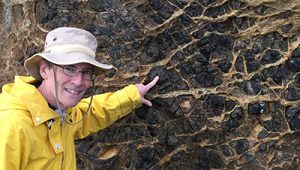EAGE-EAG Webinar: Friday 22 April 10:00-10:45 CET
Mineral carbonation: Is it an option for the worldwide storage of CO2?
Speaker: Eric H. Oelkers
Participation is free, just sign up to attend.

Eric Oelkers pointing at carbonate veins in southern Australia.
Abstract
The challenge of global warming compels the development of numerous carbon-dioxide storage options to address the large scale and diverse sources of this greenhouse gas. One compelling option is mineral carbonation, involving the formation of carbonate minerals from reactions between CO2 and non-carbonate minerals. This option is particularly favorable as 1) this storage is safe over the long term – the average lifetime of a carbonate mineral can exceed 200 million years in the crust, 2) energetically favorable, and 3) cost effective. The most considered starting materials are basaltic or ultramafic rocks owing to their abundant divalent metals and high reactivities. Mineral carbonation of these rocks is accelerated by the dissolution of CO2 into water, creating a reactive acidic fluid. The acidity of this fluid promotes the dissolution of basaltic and ultramafic rocks, which both releases divalent metals to the aqueous fluid and increases its pH (e.g. increases alkalinity). Both processes favor the carbonation of the water dissolved CO2.
The large interest in limiting the CO2 content of the atmosphere, and the potential for financial gain has motivated a large number of efforts to upscale and commercialize carbon mineralization, both in situ (e.g. injecting CO2 into suitable rock formations in the subsurface) or ex-situ by placing ground reactive rock in smokestacks, in soils, or in the oceans. Success to date has been limited. In-situ mineralization at a commercial scale has been limited to the success of CarbFix in Iceland. In-situ carbon mineralization projects is limited in most places by high infrastructure costs and environmental regulations. Ex-situ efforts are largely limited by verification of carbonation itself. This is because the products of basalt or an ultramafic rock dissolution reaction can be consumed by numerous reactions other than carbonation, such as clay mineral formation. Such alterative reactions result in no net carbon storage. To date ex-situ mineralization has been best demonstrated in mine waste piles, where the mineral brucite rapidly transforms to hydrous magnesium carbonate minerals. Perhaps the most exciting potential for ex-situ carbonation technology is mineral cycling, which when developed commercially has the potential to capture CO2 directly from the atmosphere at a far lower cost than alternative approaches.
About the speaker
Eric H. Oelkers was a co-founder of CarbFix and served as its co director from 2006 to 2020. He has been professor at University College London, Research Director at the CNRS and adjunct professor at the University of Iceland. Eric’s research focuses on developing the fundamental geochemical basis for sustainable growth and managing the Earth, including developing the technology for the mineral storage of CO2. Eric has also made substantial contributions to the understanding of the thermodynamics and kinetics of water-rock interactions, having published over 200 papers in international journals. Eric received his undergraduate degrees in Chemistry and in Earth and Planetary sciences from the Massachusetts Institute of Technology, and his doctorate from the University of California. He is co-editor of Geochemical Perspective Letters. He has previously served as President of the European Association for Geochemistry, director of the Geochemical Society, co-editor of Chemical Geology, associate editor of Geochimica et Cosmochimica Acta, and guest editor of Elements.
About the EAGE-EAG Special Interest Community on Geochemistry
 This is a special interest community by EAGE (the European Association of Geoscientists and Engineerings) and EAG (the European Association of Geochemistry). Through this collaboration, we invite you to participate in discussions, share news and ideas, and discover all the opportunities offered by the two societies! The network is open to everyone working or interested in the fields of organic and inorganic geochemistry, as well as their multidisciplinary connections.
This is a special interest community by EAGE (the European Association of Geoscientists and Engineerings) and EAG (the European Association of Geochemistry). Through this collaboration, we invite you to participate in discussions, share news and ideas, and discover all the opportunities offered by the two societies! The network is open to everyone working or interested in the fields of organic and inorganic geochemistry, as well as their multidisciplinary connections.
Join the group on LinkedIn

